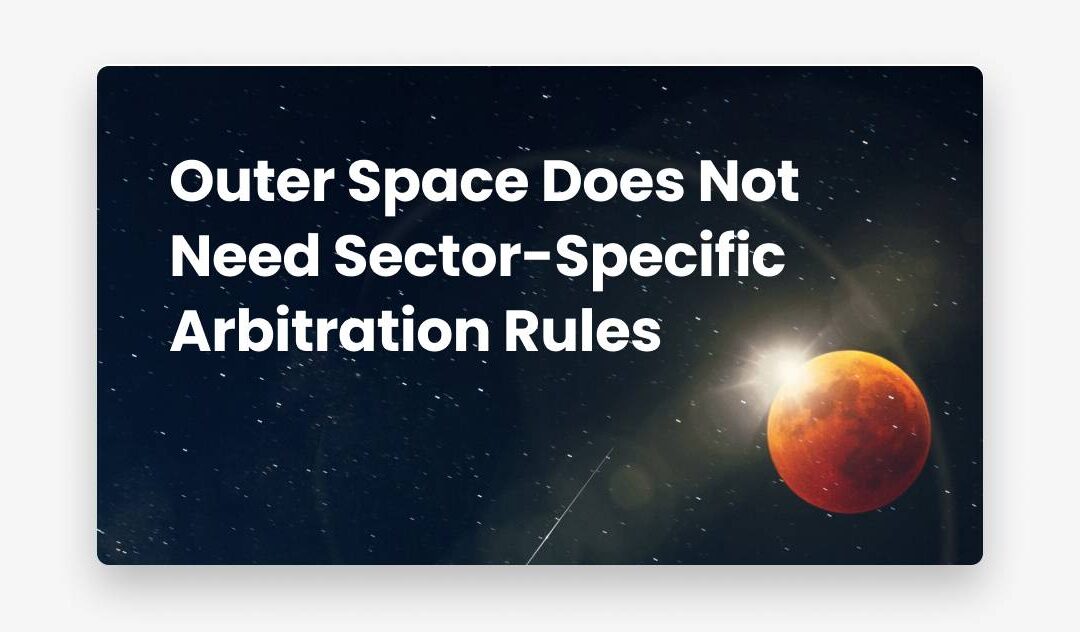Investor-State Space Arbitration Rules By Ben Love and Sagar GuptaAs foreshadowed in previous blog...

Outer Space Does Not Need Sector-Specific Arbitration Rules
Outer Space Does Not Need Sector-Specific Arbitration Rules
By Tobias Meier
Does outer space need sector-specific arbitration rules? On 6 December 2011, the Permanent Court of Arbitration (PCA) published its Optional Rules for Arbitration of Disputes Relating to Outer Space Activities (Optional Rules). They were created to provide a voluntary and binding dispute resolution mechanism specifically tailored to outer space activities (see Fausto Pocar, An Introduction to the PCA’s Optional Rules for Arbitration of Disputes Relating to Outer Space Activities, Journal of Space Law, Vol. 38, No. 1, p. 171). Since then, both the PCA (see CC/Devas (Mauritius) Ltd., Devas Employees Mauritius Private Limited and Telecom Devas Mauritius Limited v. India, PCA Case No. 2013-09; Deutsche Telekom v. India, PCA Case No. 2014-10) and other arbitration institutions (see Viva Dadwal and Madeleine Macdonald, Arbitration of Space-Related Disputes: Case Trends and Analysis, https://www.mcgill.ca/iasl/files/iasl/arbitration_of_space-related_disputes.pdf, p. 6) have administered space-related disputes. None of them was arbitrated under the Optional Rules, though. This inevitably raises the question of whether outer space activities actually require specific arbitration rules. Or could it be that other arbitration institutions such as the International Chamber of Commerce (ICC) or the London Court of International Arbitration (LCIA) are just as well-positioned to manage space-related disputes? A closer look at some of the characteristics of outer space activities which led the PCA to adopt the Optional Rules should provide valuable insights into these questions.
Technical Expertise
Launching objects into outer space is highly complex. It requires a lot of technical expertise to operate in this unique environment. Accordingly, it also requires technical expertise to resolve space-related disputes. This is why parties involved in such a dispute often choose arbitration instead of adjudication by state courts. In arbitration, they are free to choose arbitrators who offer both the legal and technical expertise (see Fausto Pocar, An Introduction to the PCA’s Optional Rules for Arbitration of Disputes Relating to Outer Space Activities, Journal of Space Law, Vol. 38, No. 1, pp. 178 et seq.).
The Optional Rules aid the parties in finding suitable arbitrators. Under Article 10(4) of the Optional Rules, the Secretary-General of the PCA shall compile a list of competent arbitrators. While there is no denial that such a list will help the parties find competent arbitrators, it does not necessarily explain the need for a sector-specific set of arbitration rules. After all, there is no inherent correlation between the choice of arbitrators and the applicable arbitration rules. Rather, arbitrators will most likely offer their services irrespective of the arbitration rules. In light of this, one may argue that compiling a list of arbitrators could have sufficed.
Confidentiality
Apart from involving complex technical issues, the space industry is also highly competitive, especially when it comes to the costs involved. By radically decreasing the costs of launching rockets into outer space, the space industry has overcome the major limitation to outer space activities, giving states and private actors alike equitable access to outer space (see Wendy Whitman Cobb, How SpaceX lowered costs and reduced barriers to space, 1 March 2019, https://theconversation.com/how-spacex-lowered-costs-and-reduced-barriers-to-space-12586). As the costs involved remain crucial, companies have an understandable interest in keeping their approaches to cost reduction (e.g. modifications and reuse of rocket parts) a secret.
The Optional Rules aid the parties in their need for confidentiality. Under Article 17(6) of the Optional Rules, a party may apply to have information classified as confidential. Moreover, under Article 17(8) of the Optional Rules, the arbitral tribunal may appoint a confidentiality adviser who will report to the arbitral tribunal on issues designated as confidential.
As was the case before with respect to finding suitable arbitrators, here too, the need for a sector-specific set of arbitration rules does not become readily apparent. There is no apparent difference between companies in the space industry and companies in other areas of business when it comes to their desire of keeping certain information a secret. This is why companies generally choose arbitration (see Fausto Pocar, An Introduction to the PCA’s Optional Rules for Arbitration of Disputes Relating to Outer Space Activities, Journal of Space Law, Vol. 38, No. 1, p. 179). This is also why other arbitration rules contain very similar provisions (see e.g. Article 22(3) of the 2021 ICC Arbitration Rules according to which the arbitral tribunal, upon the request of any party, may take measures for the protection of trade secrets and confidential information).
Involvement of States
Finally, outer space activities involve states. This has not only been true for the better part of the last 65 years (it all started in 1957 when the Soviets successfully launched Sputnik 1). It still holds true. After all, the activities of private entities in outer space continue to require authorization and continuing supervision by the appropriate state party to the 1967 Outer Space Treaty.
There are various articles in the Optional Rules concerning the possibility that states might be involved in a space-related dispute:
- Article 1(2) stipulates that the agreement to arbitrate under the Optional Rules constitutes a waiver of immunity to jurisdiction. While it might certainly be helpful to have such an explicit declaration, it merely is a declaratory statement. As Fausto Pocar correctly points out, consent to arbitration generally constitutes a waiver of immunity to jurisdiction (see Fausto Pocar, An Introduction to the PCA’s Optional Rules for Arbitration of Disputes Relating to Outer Space Activities, Journal of Space Law, Vol. 38, No. 1, p. 182).
- Article 6(1) stipulates that the Secretary-General of the PCA shall serve as appointing authority. The PCA argued that, as an intergovernmental institution, it would be better positioned to manage space-related disputes than other private institutions (see Fausto Pocar, An Introduction to the PCA’s Optional Rules for Arbitration of Disputes Relating to Outer Space Activities, Journal of Space Law, Vol. 38, No. 1, p. 184). So far, states and state entities do not seem to concur. Although they have been involved in space-related disputes (see Viva Dadwal and Madeleine Macdonald, Arbitration of Space-Related Disputes: Case Trends and Analysis, https://www.mcgill.ca/iasl/files/iasl/arbitration_of_space-related_disputes.pdf, p. 5), they have not chosen the Optional Rules.
The possibility of constituting an arbitral tribunal constituted of five instead of three or arbitrators is another concession to issues of state sovereignty that might be involved.
Low Level of Awareness Among Private Entities
Charles Rosenberg and Viva Dadwal have attributed the limited success of the Optional Rules among others to the fact that the PCA enjoys little awareness among private entities (Charles Rosenberg and Viva Dadwal, The 10 Year Anniversary of the PCA Outer Space Rules: A Failed Mission or The Next Generation?, 16 February 2021, http://arbitrationblog.kluwerarbitration.com/2021/02/16/the-10-year-anniversary-of-the-pca-outer-space-rules-a-failed-mission-or-the-next-generation/). Even if this were true, though, one might still argue that the low level of awareness stems from the fact that other institutions are just as competent to manage space-related disputes. This should particularly be true given that so far most space-related disputes have been commercial in nature (see Viva Dadwal and Madeleine Macdonald, Arbitration of Space-Related Disputes: Case Trends and Analysis, https://www.mcgill.ca/iasl/files/iasl/arbitration_of_space-related_disputes.pdf, p. 5). After all, other institutions such as the ICC or LCIA have a great deal of experience in managing these kinds of disputes.
Outer Space Does Not Need Sector-Specific Arbitration Rules
Surely, there are various reasons why the Optional Rules have not been applied in an actual space-related dispute. When examining the characteristics of outer space activities, one cannot help but notice that arbitrating under the Optional Rules does not become readily apparent. Especially with a view to commercial disputes, other institutions (such as the ICC or LCIA) seem just as capable of accounting for the characteristics of outer space activities. They also provide for the requisite technical expertise, confidentiality and waiver of immunity. What is more: They benefit from a high level of awareness among private entities. Against this background, one may doubt whether we will see a significant increase in cases arbitrated under the Optional Rules.
As for any future prospects of the Optional Rules: Much will likely depend on the subject-matter of future arbitrations. Its vast experience in dealing with disputes involving states and state entities could prove to be more beneficial if, and when, space-related arbitrations leave the sphere of predominantly commercial matters.
The topic of sector-specific arbitration rules and institutions for the space industry has been further addressed here.
You might also like
Investor-State Space Arbitration Rules
Inter-State Space Arbitration
Inter-State Space Arbitration By Luc ColinOn 26 April 2022, the Space Arbitration Association...
Private Parties in Space Law
Private Parties in Space Law By Luca ErhartThere needs to be room for private parties in...










